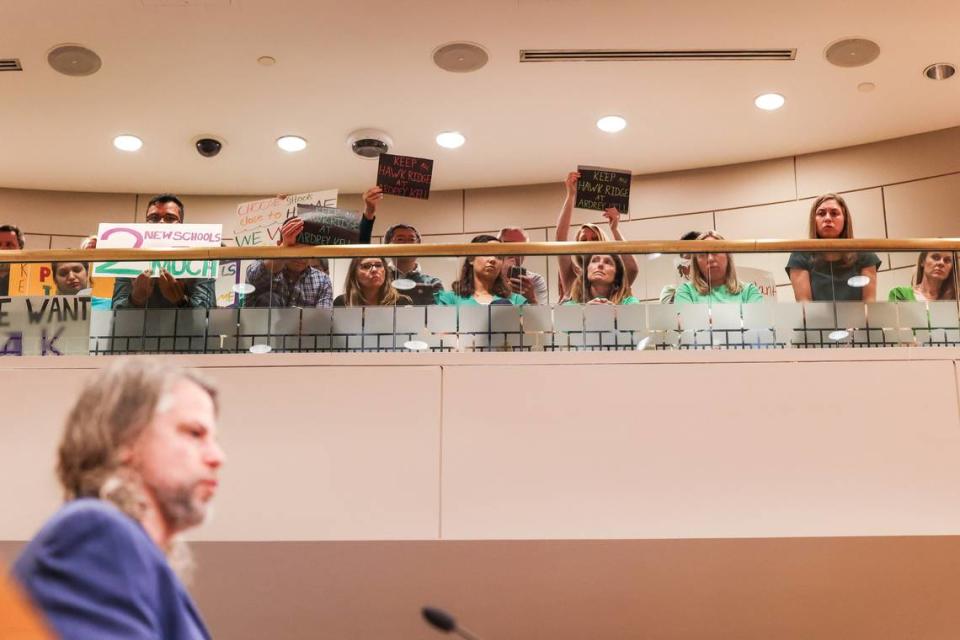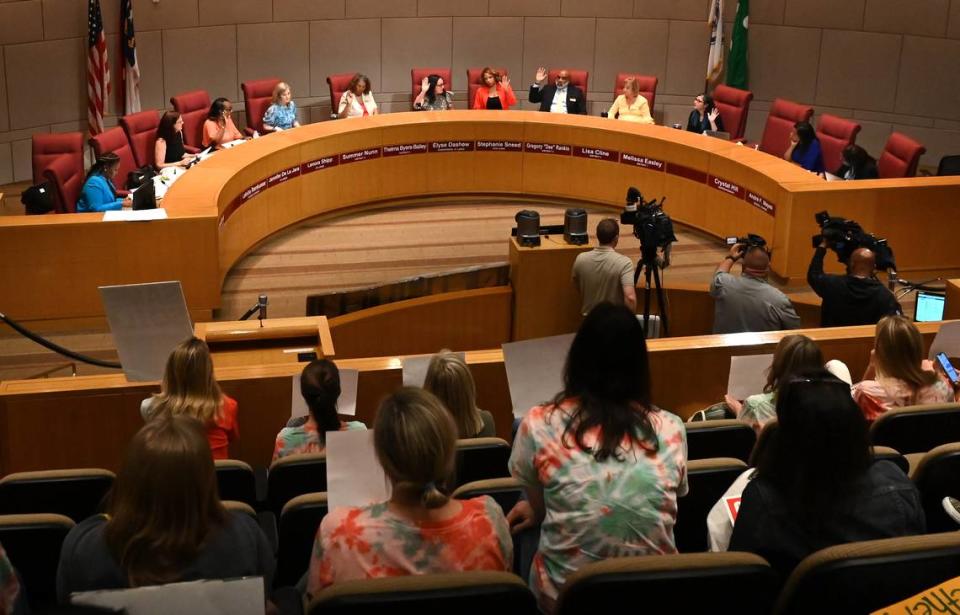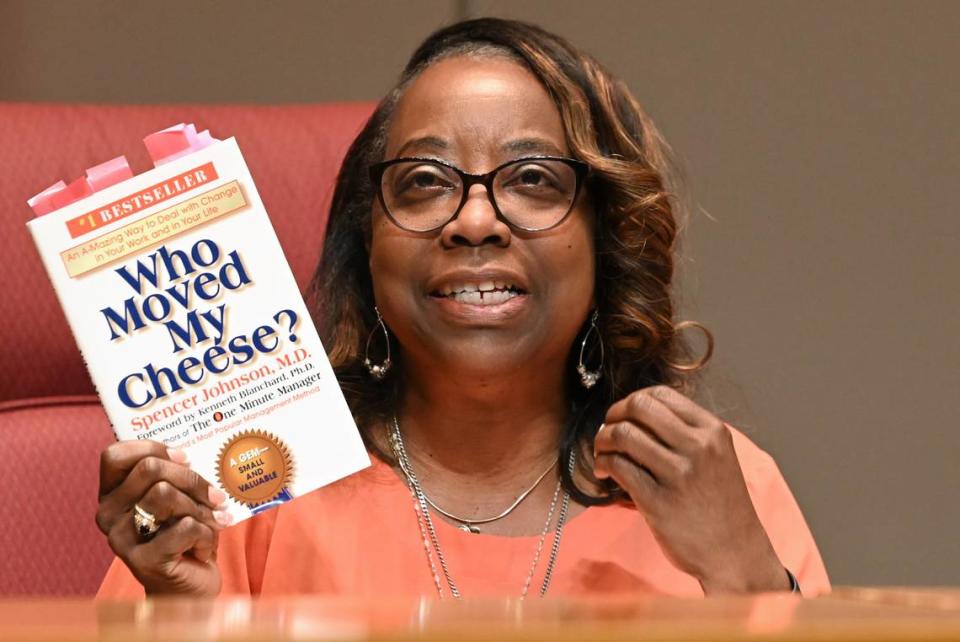Behind south Charlotte CMS maps: Data scientists, thousands of emails and happy parents?
Elizabeth Gass is 8 years old and ecstatic she and her sister are now zoned for Providence High School.
Even better, the third-grade student at Olde Providence Elementary will be able to see her sister play sports because the school is close. It’s closer than where the family would’ve gone without the newly approved south Charlotte student reassignment plan.
Elizabeth was so excited she emailed Charlotte Mecklenburg Schools officials with her thoughts last week and became the youngest person to share feedback, board chair Elyse Dashew says.
Albeit a short and sweet note, Elizabeth’s letter was one of thousands CMS staff and board members received related to changed school attendance lines in south Charlotte. The district shifted around students from dozens of communities because of a new high and middle school being built to relieve overcrowding. The sheer volume of community input helped drive the district’s work.

Much of the input was negative, coming from parents who didn’t want a change in their feeder patterns or said they were blindsided by changes they weren’t expecting, school board members told The Charlotte Observer. But some feedback remained positive, thanking CMS for its willingness to listen to residents.
“The best solution was found thanks to a remarkable level of dedication and collaboration from parents, CMS staff, (Superintendent Crystal) Hill, and the board,” Dashew said.
Staff members first started looking at south Charlotte boundaries in February 2022. But work on those boundaries began in earnest early this year with a reset that included meetings held in person and virtually amid complaints about failed transparency.
It required the school board’s OK, but they were a sounding board for opinions from affected families and the judges for maps. Staffers and Superintendent Crystal Hill owned the task of drawing lines.
Hill estimates staff spent thousands of hours coming up with a plan that she, in turn, presented to the school board for approval. All of the time and energy was done knowing one fact: it would be impossible to make everyone happy.
And it ended with a lesson: next time needs to be even better.
“The perfect process, even if it exists, still does not guarantee each individual’s perfect outcome,” said Dennis LaCaria, the executive director of facilities and real estate planning for CMS. “We are charged with making the best possible decisions for the greatest number of students for the longest possible time.”
How did CMS judge maps?

Summer Nunn stopped counting in late December.
The CMS board member received more than 4,000 emails about the student assignment plan in less than a month from when she took office. Lisa Cline, also a new board member, received more than 200 emails from parents a day at one point this spring.
Angry or not, LaCaria said the district is thankful for the “active participation” from thousands of people. One part of that feedback: a parent work group.
Throughout the process, drafts and Hill’s final recommendation got presented to a parent work group with representatives from affected schools and the community. That meant more than 85 parents meeting to talk about every draft in addition to meetings for the general public.
When CMS decided on the reset, where staff basically started fresh, LaCaria says they began with a single map of the southern part of the district. They used three primary data scientists, and their work was managed, reviewed, analyzed or revised by nearly every CMS department, including principals and members of the magnet and transportation departments.
They used factors like home-to-school distance, keeping in one feeder pattern instead of splitting them off at the middle or high school level and balancing diversity at each school.
Legacy enrollment

Another place where input made a difference: letting students stick with their current path if they’ll be a junior or senior in the 2024-2025 school year.
Bo King, who can walk to Providence High from his house, said nearly all parents agreed on legacy enrollment for juniors and seniors in high school and eighth graders. For example, students who will be freshmen in 2023-24 whose high school assignment will change from Myers Park High to South Mecklenburg or Providence High in 2024-25 are eligible to start at their newly assigned school this fall.
There will also be a transfer process.
“Junior year is tough. You’re applying to colleges. You need those teacher recommendations,” Cline told the Observer during a live-streamed interview on Wednesday. “Let us stay at our school. Also for the ninth-graders who are being moved. CMS has done something totally radical and allowing ninth-graders and providing transportation for them if they want to go to their newly assigned school. That’s amazing.”

Another topic that simmered to the surface of parent concerns: diversity.
Heidi Carney has been an engaged CMS parent for 17 years while living in south Charlotte. She’s worked in CMS for five years in various capacities, including as a tutor, teacher’s aide and substitute teacher.
Throughout the reassignment process, Carney, whose youngest daughter will be a junior when the new high school opens, followed all notifications, figures and maps the district offered. Carney says she became increasingly aware that balanced socioeconomic diversity needed to be the priority.
“I was skeptical that this was even possible in south Charlotte,” she said. “My work in both low and high SES schools instilled in me that every student deserves an equal opportunity at a great education. The passed proposal achieves what I thought was impossible — equitable SES distribution throughout all the south Charlotte high schools.”
Carney says the redistricting process was like no other.
“I am grateful to the board and their staff for their tireless efforts,” Carney said. “The level of engagement has given me hope. I pray our south Charlotte community can heal, unite and open our new schools with the zeal we’ve shown this past year.”
A better process

But LaCaria and school board members say the district’s student reassignment process could be better.
For starters, LaCaria says, officials want to debrief with the community and get feedback from parents.
“Maybe three drafts before the superintendent’s recommendation?” he wondered in an interview with the Observer.
Nunn says she hopes CMS learned enough about what worked with the community and what didn’t. That will likely include putting procedures in place for equal amounts of time between drafts for feedback.
“We learned quite a bit, including that focusing on one map at a time really helps to hone the conversation,” LaCaria said. “ While the expanded workgroup was of tremendous benefit, we want to make sure that we are maximizing their contribution and participation, including helping us communicate with each of their school communities.”
Still, there are people left feeling content.
“This plan will enhance the schools directly by relieving overcrowding,” King said. “The indirect enhancements could be even more powerful. The conversation around the plan really galvanized the community. It also laid bare some of the ways that our county is broken.”

 Yahoo Sports
Yahoo Sports 